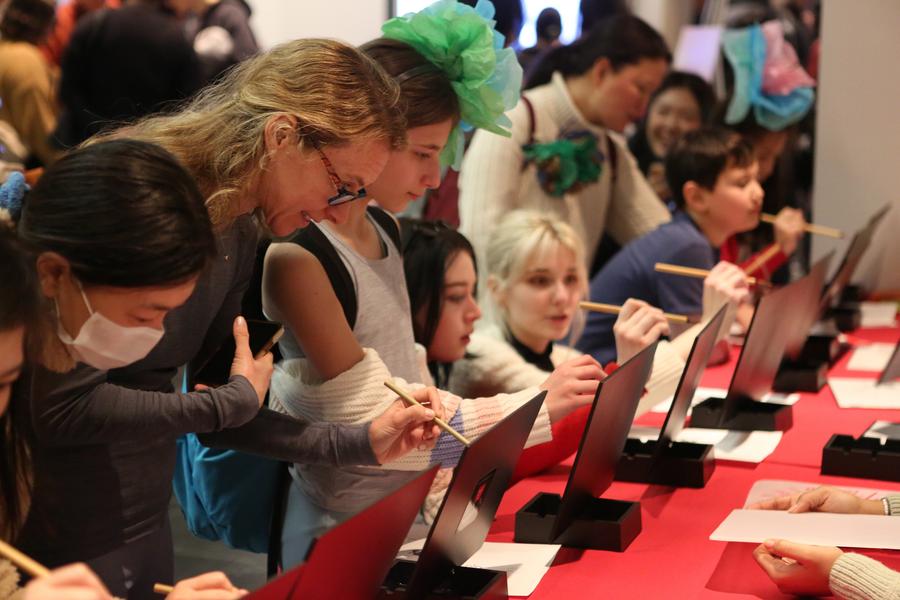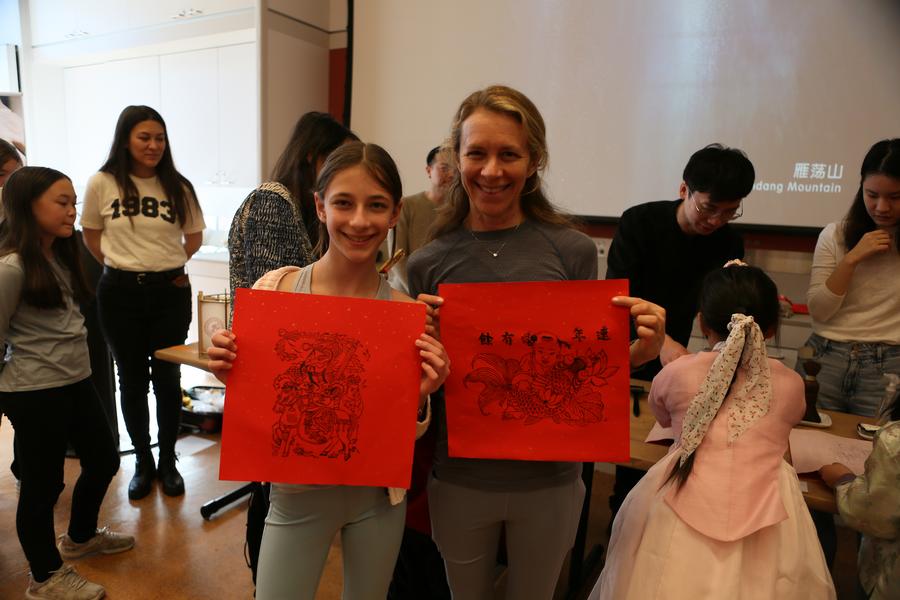Feature: The Met immerses American families in Chinese New Year traditions

Visitors watch a dragon dance performance during a Lunar New Year celebration event at the Metropolitan Museum of Art in New York, the United States, on Feb. 3, 2024. (Xinhua/Zhang Fengguo)
The Metropolitan Museum of Art has become a sought-after destination for those who want to celebrate the Lunar New Year.
by Xinhua writers Yang Shilong, Xing Yue, Xie E
NEW YORK, Feb. 4 (Xinhua) -- Hundreds of American parents and kids enjoyed a rare glimpse of China's intangible cultural heritage -- traditional woodblock printing -- at the Year of the Dragon celebrations staged by The Metropolitan Museum of Art on Saturday.
Artisans from Zhejiang Provincial Cultural Center showcased the intricate artistic process, offering visitors a close encounter with one of the most vibrant traditions of the Chinese New Year.
"I learned about the Chinese culture at this event and like how woodblock printing is done and how they make all the art stuff ... It's a cool culture to me," said Grace Wolfard, a U.S. girl born in the Year of the Rabbit. "It's fun how the steps you need to make a print like this. I am interested in the culture and maybe someday going to China."

Visitors learn Chinese calligraphy during a Lunar New Year celebration event at the Metropolitan Museum of Art in New York, the United States, on Feb. 3, 2024. (Xinhua/Zhang Fengguo)
China's traditional woodblock printing dates back to the Tang Dynasty, and takes four major steps and approximately 30 procedures to produce a print.
Ruan Jing, director of Zhejiang Provincial Cultural Center, expressed delight in the fact that American children like Grace enjoyed a hands-on experience of this ancient printing technique.
"We believe a live show here could give local parents and children a more intuitive feel of the Chinese New Year traditions," said Ruan, adding their delegation also included artisans of calligraphy, embroidery, and spring couplets writing.
The event marked The Met's sixth consecutive year hosting Lunar New Year celebrations, featuring lively performances, interactive activities, and artist-led workshops for all ages.
Heidi Holder, The Met's Chair of Education, told Xinhua that the museum has become a sought-after destination for those who want to celebrate the Lunar New Year.
"It was super popular last year. We had 18,000 people here ... We have become a destination for people who want to celebrate (the Lunar New Year)," she said.
"I think it really does create a very easy or enjoyable point of entry for people who are not familiar (with the Lunar New Year culture)," she added.

Visitors show Chinese woodblock printing works they made during a Lunar New Year celebration event at the Metropolitan Museum of Art in New York, the United States, on Feb. 3, 2024. (Xinhua/Zhang Fengguo)
Peter Lin, a trombonist and leader of the AAPI Jazz Collective, agreed.
"We're trying to bring our own culture to a new audience, especially in a way that they haven't heard it before. This is kind of an entrance point for them to learn more about our culture and there is no better way in my opinion than through music," Lin said.
In addition to the festivities, the museum presented an exhibition showcasing over two dozen works of dragon from the museum's permanent collection.
These works, spanning various mediums, illustrated the dragon's significance as a symbol of imperial authority, a force dispelling evil influences, and a benevolent deity bringing auspicious rain.
Notable pieces included a third-century BCE jade pendant, a seventh-century bronze mirror, and a massive sixteenth-century jar of blue and white porcelain.
- Chinese premier says China's market is always open to foreign businesses
- American students, teachers engage in Chinese poetry-learning in China
- Chinese wildlife association to work with U.S. zoo on giant panda conservation
- China, U.S. make preparations to send a pair of giant pandas to San Francisco Zoo in 2025
- Xinhua Headlines: Antiquities repatriation fosters deeper China-U.S. cultural exchanges

